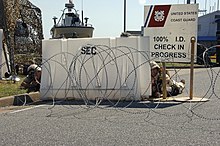
Force protection (FP) is the concept of protecting military personnel, family members, civilians, facilities, equipment and operations from threats or hazards in order to preserve operational effectiveness and contribute to mission success.[1][2][3] It is used as a doctrine by members of NATO.[3]
The concept of force protection was initially created after the Beirut barrack bombings in Lebanon in 1983. With its Cold War focus toward potential adversaries employing large conventional military forces at the time (e.g., the Soviet Union, etc.), the U.S. military had become complacent and predictable with regard to asymmetric attacks by state and non-state actors employing terrorist and guerrilla methodologies [citation needed]. As a result, during what were ostensibly peacekeeping operations by a U.S. Marine Corps landing force ashore in Lebanon in 1983, two explosives-laden civilian trucks were able to breach the perimeter of the Marines' containment area and detonate the car bombs adjacent to the Marines' billeting areas.
Force protection was subsequently implemented throughout the Defense Department (and later adopted by the Coast Guard) to ensure that such a scenario never happened to U.S. forces again. Force protection itself is characterized by changing protective tactics to avoid becoming predictable.[4]
- ^ "Force Protection". Commander, Navy Installations Command. Retrieved 14 August 2021.
- ^ "DOD Dictionary of Military and Associated Terms, November 2019" (PDF). Archived from the original (PDF) on 2020-02-18. Retrieved 2020-01-03.
- ^ a b "Allied Joint Doctrine for Force Protection" (PDF). Ministry of Defence. Retrieved 14 August 2021.
- ^ "Guided Discussion - Force Protection" (PDF). Archived from the original (PDF) on 2015-11-23. Retrieved 2015-11-10.
